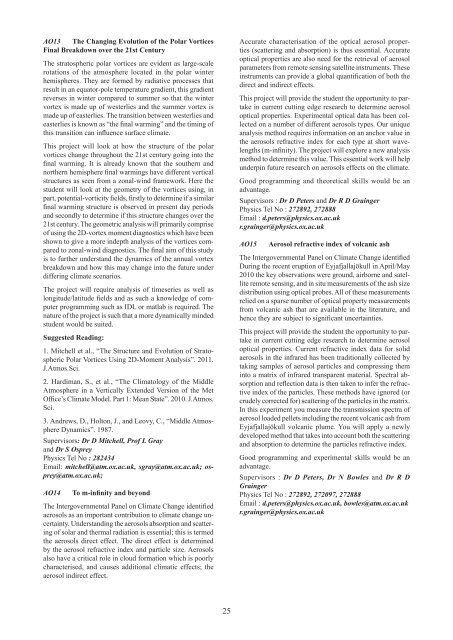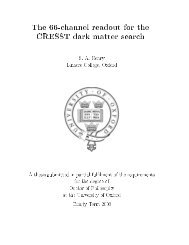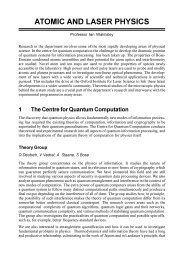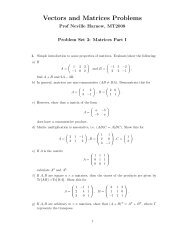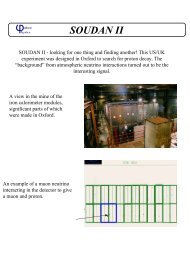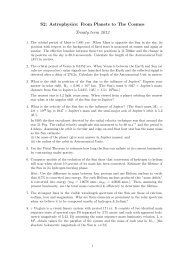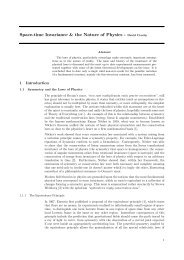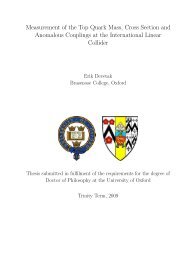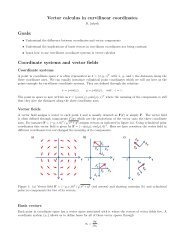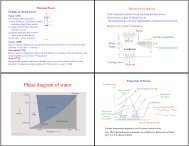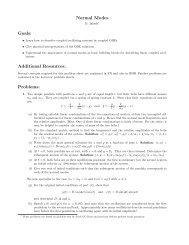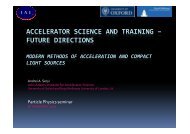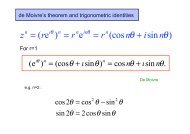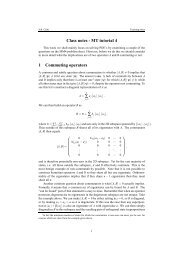MPhys cover_19September2011.indd - Department of Physics ...
MPhys cover_19September2011.indd - Department of Physics ...
MPhys cover_19September2011.indd - Department of Physics ...
Create successful ePaper yourself
Turn your PDF publications into a flip-book with our unique Google optimized e-Paper software.
AO13 The Changing Evolution <strong>of</strong> the Polar Vortices<br />
Final Breakdown over the 21st Century<br />
The stratospheric polar vortices are evident as large-scale<br />
rotations <strong>of</strong> the atmosphere located in the polar winter<br />
hemispheres. They are formed by radiative processes that<br />
result in an equator-pole temperature gradient, this gradient<br />
reverses in winter compared to summer so that the winter<br />
vortex is made up <strong>of</strong> westerlies and the summer vortex is<br />
made up <strong>of</strong> easterlies. The transition between westerlies and<br />
easterlies is known as “the final warming” and the timing <strong>of</strong><br />
this transition can influence surface climate.<br />
This project will look at how the structure <strong>of</strong> the polar<br />
vortices change throughout the 21st century going into the<br />
final warming. It is already known that the southern and<br />
northern hemisphere final warmings have different vertical<br />
structures as seen from a zonal-wind framework. Here the<br />
student will look at the geometry <strong>of</strong> the vortices using, in<br />
part, potential-vorticity fields, firstly to determine if a similar<br />
final warming structure is observed in present day periods<br />
and secondly to determine if this structure changes over the<br />
21st century. The geometric analysis will primarily comprise<br />
<strong>of</strong> using the 2D-vortex moment diagnostics which have been<br />
shown to give a more indepth analysis <strong>of</strong> the vortices compared<br />
to zonal-wind diagnostics. The final aim <strong>of</strong> this study<br />
is to further understand the dynamics <strong>of</strong> the annual vortex<br />
breakdown and how this may change into the future under<br />
differing climate scenarios.<br />
The project will require analysis <strong>of</strong> timeseries as well as<br />
longitude/latitude fields and as such a knowledge <strong>of</strong> computer<br />
programming such as IDL or matlab is required. The<br />
nature <strong>of</strong> the project is such that a more dynamically minded<br />
student would be suited.<br />
Suggested Reading:<br />
1. Mitchell et al., “The Structure and Evolution <strong>of</strong> Stratospheric<br />
Polar Vortices Using 2D-Moment Analysis”. 2011.<br />
J.Atmos.Sci.<br />
2. Hardiman, S., et al., “The Climatology <strong>of</strong> the Middle<br />
Atmosphere in a Vertically Extended Version <strong>of</strong> the Met<br />
Office’s Climate Model. Part 1: Mean State”. 2010. J.Atmos.<br />
Sci.<br />
3. Andrews, D., Holton, J., and Leovy, C., “Middle Atmosphere<br />
Dynamics”. 1987.<br />
Supervisors: Dr D Mitchell, Pr<strong>of</strong> L Gray<br />
and Dr S Osprey<br />
<strong>Physics</strong> Tel No : 282434<br />
Email: mitchell@atm.ox.ac.uk, sgray@atm.ox.ac.uk; osprey@atm.ox.ac.uk;<br />
AO14<br />
To m-infinity and beyond<br />
The Intergovernmental Panel on Climate Change identified<br />
aerosols as an important contribution to climate change uncertainty.<br />
Understanding the aerosols absorption and scattering<br />
<strong>of</strong> solar and thermal radiation is essential; this is termed<br />
the aerosols direct effect. The direct effect is determined<br />
by the aerosol refractive index and particle size. Aerosols<br />
also have a critical role in cloud formation which is poorly<br />
characterised, and causes additional climatic effects; the<br />
aerosol indirect effect.<br />
Accurate characterisation <strong>of</strong> the optical aerosol properties<br />
(scattering and absorption) is thus essential. Accurate<br />
optical properties are also need for the retrieval <strong>of</strong> aerosol<br />
parameters from remote sensing satellite instruments. These<br />
instruments can provide a global quantification <strong>of</strong> both the<br />
direct and indirect effects.<br />
This project will provide the student the opportunity to partake<br />
in current cutting edge research to determine aerosol<br />
optical properties. Experimental optical data has been collected<br />
on a number <strong>of</strong> different aerosols types. Our unique<br />
analysis method requires information on an anchor value in<br />
the aerosols refractive index for each type at short wavelengths<br />
(m-infinity). The project will explore a new analysis<br />
method to determine this value. This essential work will help<br />
underpin future research on aerosols effects on the climate.<br />
Good programming and theoretical skills would be an<br />
advantage.<br />
Supervisors : Dr D Peters and Dr R D Grainger<br />
<strong>Physics</strong> Tel No : 272892, 272888<br />
Email : d.peters@physics.ox.ac.uk<br />
r.grainger@physics.ox.ac.uk<br />
AO15<br />
Aerosol refractive index <strong>of</strong> volcanic ash<br />
The Intergovernmental Panel on Climate Change identified<br />
During the recent eruption <strong>of</strong> Eyjafjallajökull in April/May<br />
2010 the key observations were ground, airborne and satellite<br />
remote sensing, and in situ measurements <strong>of</strong> the ash size<br />
distribution using optical probes. All <strong>of</strong> these measurements<br />
relied on a sparse number <strong>of</strong> optical property measurements<br />
from volcanic ash that are available in the literature, and<br />
hence they are subject to significant uncertainties.<br />
This project will provide the student the opportunity to partake<br />
in current cutting edge research to determine aerosol<br />
optical properties. Current refractive index data for solid<br />
aerosols in the infrared has been traditionally collected by<br />
taking samples <strong>of</strong> aerosol particles and compressing them<br />
into a matrix <strong>of</strong> infrared transparent material. Spectral absorption<br />
and reflection data is then taken to infer the refractive<br />
index <strong>of</strong> the particles. These methods have ignored (or<br />
crudely corrected for) scattering <strong>of</strong> the particles in the matrix.<br />
In this experiment you measure the transmission spectra <strong>of</strong><br />
aerosol loaded pellets including the recent volcanic ash from<br />
Eyjafjallajökull volcanic plume. You will apply a newly<br />
developed method that takes into account both the scattering<br />
and absorption to determine the particles refractive index.<br />
Good programming and experimental skills would be an<br />
advantage.<br />
Supervisors : Dr D Peters, Dr N Bowles and Dr R D<br />
Grainger<br />
<strong>Physics</strong> Tel No : 272892, 272097, 272888<br />
Email : d.peters@physics.ox.ac.uk, bowles@atm.ox.ac.uk<br />
r.grainger@physics.ox.ac.uk<br />
25


